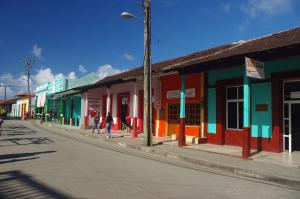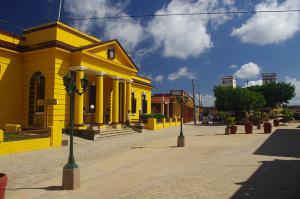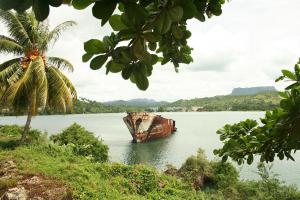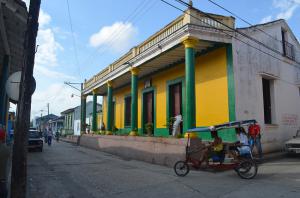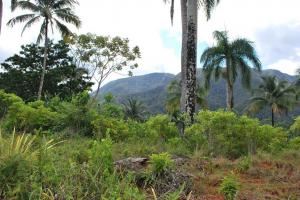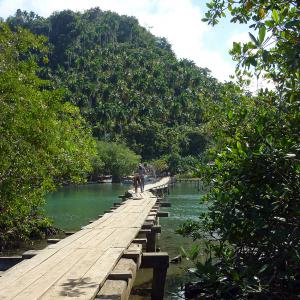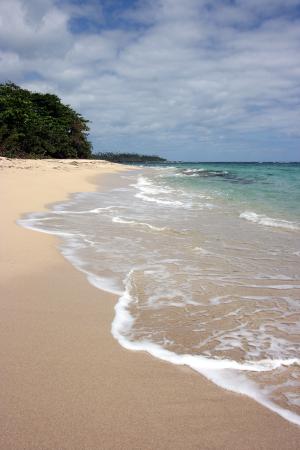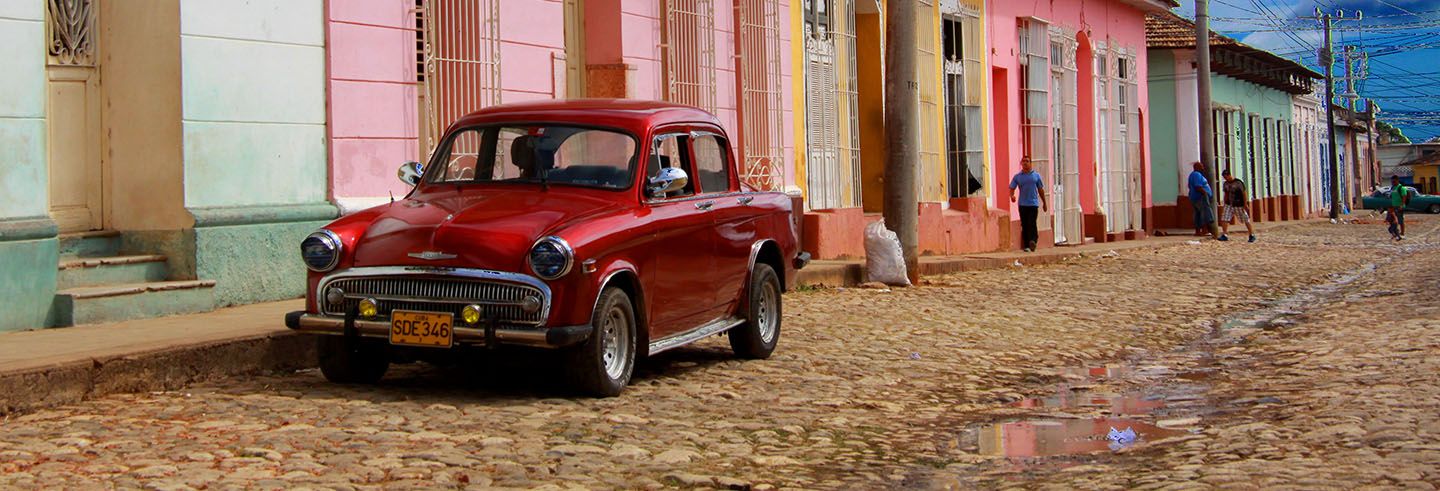

Baracoa, Cuba
Fall in love with Baracoa, the First City of Cuba and and a natural paradise in the most eastern point of the island
Baracoa is the oldest city and one of the most charming ones in Cuba. It is located in the Guantánamo province in one the most eastern points of the island. It is a home for a large variety of unique sceneries and natural scenes among the most inviting ones of the Antillean islands.
Its foundation dates back to 1511 when the Spanish Conquistadors commanded by Diego Velázquez de Cuéllar arrived in the island and it is known as the First City of Cuba.
The region offers nature lovers the possibility to enjoy the real paradise. Baracoa is situated next to the Bahía de Miel (Miel Bay) which together with the land make spectacular white sand beaches crowned by majestic palm trees. Take a look at the horizon and you will see the Bella Durmiente, a mountain that looks like a sleeping woman and El Yunque, a hill similar to a table. This forms part of the Cuchillas del Toa Biosphere Reserve which is a good place to admire diverse endemic flora and fauna. The Parque Nacional Alejandro de Humboldt (Alejandro de Humboldt National Park) is very attractive as well, which was declared as a World Heritage Site by the UNESCO thanks to its natural richness and its perfect mountain ecosystem conservation of Cuba.
Baracoa is not only full of heavenly natural sceneries, but also a land abundant in history, art and old traditions: come and discover the local Baracoa! Let unique experiences take you, such as a demonstration of chocolate elaboration process made by local countrymen or the traditional Cuban dance shows of Grupo Musical Portador del Género Comunitario.
See the amazing monuments, like the remains of the Fortalezas Defensivas (Defensive Fortresses) or the magnificent Catedral Nuestra Señora de la Asunción (Nuestra Señora de la Asunción Cathedral) and go through the historic periods of the city.
During your trip you could try typical Cuban food and Baracoa’s yummy specialities, such as frangollo (sweet bananas wrapped in banana leaves) or calalú (boiled cabbage leaves mixed with coconut milk and spices) and bacán (grated green banana mixed with sauces and crab, wrapped in banana leaves).
Index
- What are the best places to see in Baracoa?
- What are the best excursions to make in Baracoa?
- What are the best activities for families with children in Baracoa?
- What are the best beaches in Baracoa?
- When should one visit Baracoa?
- How can one get to Baracoa?
- Where should one stay in Baracoa?
What are the best places to see in Baracoa?
Whilst having a walk in the narrow cobblestone streets of Baracoa you can admire its buildings that have lost their colours that form part of the charm of the city. You will discover many tempting places, such as the Catedral Nuestra Señora de la Asunción (Nuestra Señora de la Asunción Cathedral), the cathedral where the Santa Cruz de la Parra placed by Christopher Columbus is kept or the Malecón de Baracos, the place where city festivals take place and where you can interact with the locals.
Some remains of the Fortalezas Defensivas (Defensive Fortresses) built by the Spanish who protected the town from pirate attacks in the 18th century are still being found in the city. The Castillo Seboruco (Seboruco Castle) and the Fuerte Punta are examples of ancient constructions which have been turned into a hotel and a restaurant afterwards. The Fuerte Matachín (Matachín Fort), which is the most important one among fortresses is the main point of the homonymous museums.
You should visit the museums if you fancy discovering the history of the area, like the Museo Fuerte Matachín (Matachín Fort Museum) where you can find historic items from the indigenous culture till the recent times as well as the Cueva del Museo Arqueológico (Cueva Archaeological Museum) which is representative of a colonial ambience. To top it all, many objects and paintings with deep archaeological value are preserved there.
What are the best excursions to make in Baracoa?
The Reserva de la Biosfera Cuchillas del Toa (Cuchillas del Toa Biosphere Reserve) and the Parque Nacional Alejandro de Humboldt (Alejandro de Humboldt National Park) offer a wide range of adventureful paths for nature lovers. Have fun in these paths full of green tropical moist forests and be amazed by the song of endemic birds which fill the place with sheer magic.
Whilst enjoying the hiking paths you might want to bathe and cool yourself down in the green waters of natural pools and rivers like the Taco River, the Santa María River, the Yumuri River or the Miel River. Afterwards, you could continue towards the impressive waterfalls, which are included in the heavenly scenery of this area. The most popular ones are the Cascada del Yunque (Yunque Falls) or the El Saltadero, which is very well-known in the Toa River area. Besides, you might want to take a boat or a dugout canoe and have a go in the river Taco, Yumurí and Toa.
History and culture fanatics might find the Cacaotero Path and the Taina excursion very captivating. The Cacaotero Path helps you to learn more about the history and the cacao cultivation traditions in Baracoa and you could pop by the one of a kind Fábrica de Chocolate (Chocolate Factory). The second excursion sums up the American Indian Taino culture. They were the ancient habitants of Baracoa who found Cristopher Columbus and it includes visits to the Matachín Museum and the Cueva del Paraíso.
What are the best activities for families with children in Baracoa?
Baracoa is the perfect destination for unforgettable trips with children, as every single excursion is accessible for everybody regardless of the age. If you search for more distinctive activities for your children you will find many astonishing places for them in the outskirts of the city. Among these places we highlight the Zoológico de Piedra de Yateras (Piedra de Yateras Zoo), which is equipped with animal sculptures made of stone or the Nguyen Van Troi Baseball Stadion of Guantánamo ideal for national sports matches.
In Santiago de Cuba you will find the Acuario Baconao (Baconao Aquarium), which is the home for numerous aquatic animals and the Museo Valle de la Prehistoria (Prehistory Valley Museum), an outdoors park with replicas of real scale dinosaurs.
More to the point, in Combinado, in the Granja de las Tortugas (Tortoise Farm), the children can learn more about the entire cycle of life of these animals, as well as the implantation with special night excursions on the beaches from May till September.
What are the best beaches in Baracoa?
In Baracoa you will find several idyllic beaches which will catch you with their fine and white sand and crystal-clear waters surrounded by a privileged natural environment with exotic palm trees, such as Miel Beach, Maguana Beach, Manglito Beach, Blanca Beach, Cajuajo Beach and Mapurisí Beach. The crystal-clear waters of these beaches take care of the home of an uncontaminated coral reef, which is an astonishing multicoloured underwater world full of fish, molluscs, sponges and starfish.
The Playa Fundadora, characterized by its gray and greenish coloured fine sand, is located in the Parque Nacional Alejandro de Humboldt (Alejandro de Humboldt National Park).
Between the mouths of Toa and Duaba rivers the Duaba Beach extends where you are able to practise surfboarding.
The Maguana Beach is the starting point for snorkeling and diving activities, which are ideal for admiring the breathtaking bottom of the sea and a lovely barrier coral.
When should one visit Baracoa?
Baracoa is the perfect destination throughout the year thanks to an idyllic climate and warm temperatures everyday.
Some of the important events are the Baracoa Cultural Week, a cultural celebration with artistic and dancey expressions in the last week of March. And in April, the Baracoa Carnivals fill the streets with authentic Cuban parades of folkloric figures and recreational activities for children and adults.
The Fiesta de las Agua takes place in August (from the 10th till the 15th of August), which is a celebration for the foundation of the First City. During the Festival Balseros del Toa (Festival of Boatmen), related with the anniversary of Baracoa, the boatmen go across the Toa River by dugout canoes and reminisce about the local traditions.
Many Festival de Plato Típico (Typical Plate Festival) take place throughout the year.
How can one get to Baracoa?
The only way to get there is via the Farola Viaduct for the ones coming from Guantánamo. It is a mountainous route with many bends characterized by many cantilever bridges keeping in mind the natural environment. We are talking about an engineering masterpiece made to connect Baracoa with the rest of Cuba, as it was totally isolated in the past. Going through this path you will experience a true adventure.
The ones coming from the western part of the island have to go through Holguín, Mayaría, Moa and Baracoa. This road is almost completely asphalted.
The Gustavo Rizo Airport (4 km) is located near the city. It is only for national flights. The nearest international airport is the Antonio Maceo de Santiago de Cuba Airport (245 km)
Tourists coming from international waters can dock their yachts in Porto Santo in the Baracoa Bay.
Where should one stay in Baracoa?
If you fancy an unforgettable experience a casa particular (private house) is your choice. Typical Baracoan dwellings are the best places to find out more about local traditions and habits. To top off your stay, you can interact better with the citizens of Baracoa.
Additionally, here are a couple of options should you search for a hotel: Hotel el Castillo, built on top of the old Seboruco Castle, one of the anti-pirate fortresses; Hotel Baracoa and Hotel La Rusa, near the breakwater; Hotel Porto Santo, near the Gustavo Rizo Airport and Hotel Plaza and Hotel Martí, in the city centre near the Cathedral.
Of course, other types of accommodations are available in Baracoa, such as the Base de Campismo El Yunque (El Yunque Camping Base) for the ones looking for unique nature experiences. Some hostels are available as well, like Hostal Rubio and Hostal Casa Grande, near the Port of Baracoa; Hostal Río Miel and Hostal Casa la Fortaleza, near the breakwater; Hostal la Habanera, near the Cathedral; Hostal José Ramón, near the Matachí Museum and Hostal las Terrazas Casa Nilson, between the Cathedral and the breakwater.
Interactive map:
Baracoa
What to see:
- Baracoa Cathedral
- Seboruco Castle
- Municipal Museum of Baracoa
- Archaeological Museum of Baracoa
- Viaducto La Farola (La Farola Viaduct)
- Boca de Yumurí
- Maguana Beach
- Duaba Beach
- Toa river
- Miel river
- Parque nacional Alejandro de Humboldt (Alejandro de Humboldt National Park)
- El Yunque
- Majayara National Park
- Chocolate Factory of Baracoa
- Cone Factory of Baracoa
- Cueva del Agua
- Veteran Centre of Baracoa
Other nearby destinations:
Why "Cuban Travel Agency"?
"Cuban Travel Agency" is part of the Visitar Cuba project, an organization of Cuban agencies whose objectives are:
- ✓ Disseminate Cuba, its culture and its heritage.
- ✓ Promote sustainable tourism.
- ✓ Support the local economy, prioritizing direct contact with Cuban agencies.
- ✓ Offer budgets without commitment and without cost, from the hand of Cuban experts.
Travel agencies and Tour Operators
If you are an agency or tour operator and you are looking for help to create trips to Cuba, trust our expert hands, we offer special prices.
© www.CubanTravelAgency.Org - All rights reserved.



